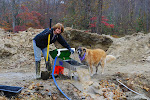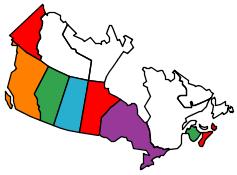


 We are camped within 20 feet or so of Prince William Sound - where the Sound narrows and channels into the small craft harbor, from where all the 6 pack charters depart. I hope to be on one of them soon. Since the salmon have also not arrived here yet, the story of the whole trip so far, the quarry will be halibut. Tides and currents and weather should be right mid week. Gotta break this poor fishing pattern soon. But meanwhile, the scenery is terrific, there's plenty of other things to do and see.
We are camped within 20 feet or so of Prince William Sound - where the Sound narrows and channels into the small craft harbor, from where all the 6 pack charters depart. I hope to be on one of them soon. Since the salmon have also not arrived here yet, the story of the whole trip so far, the quarry will be halibut. Tides and currents and weather should be right mid week. Gotta break this poor fishing pattern soon. But meanwhile, the scenery is terrific, there's plenty of other things to do and see. Here's a healthy 80 lb. halibut going under the knife at the cleaning station at the small boat harbor cleaning stations. All fish must be cleaned at specific locations in town. The waste goes into special vats that look more or less like shark cages, which are then towed out to sea and dumped when they are full.
Here's a healthy 80 lb. halibut going under the knife at the cleaning station at the small boat harbor cleaning stations. All fish must be cleaned at specific locations in town. The waste goes into special vats that look more or less like shark cages, which are then towed out to sea and dumped when they are full.The young lady in the blue coat is a scientist, "Maggie," with Alaska Fish and Game. She measures and weighs each fish brought to the cleaning stations, then afterwards removes the inner ear bones from the halibut and the Rockfish. Those bones are studied for determining the health and age of the catch, which is information used in helping set regulations in the future. After learning the process, I spent some time serving as an assistant (scribe) in the process. I learned a lot and really enjoyed the experience. I hope to do some more of it while we are here. We will have a three week stay here, so there should be plenty of time to do that- and it's a great way to see the catch as it comes off all the boats, and learn about fish I have no experience with, and in many cases, have never even seen before.



 In Florida, and just about anywhere else I have ever fished around salt water, it is the gulls and the pelicans that steal the fish off the cleaning tables if you turn your back for even a minute. But this is Alaska, where everything, even the fish steaks, are big. So here the gulls don't do the thieving; here, the eagles do the it. The golden eagles and the bald eagles. Which causes me to ask the question: Is that why they call them "Ea-gulls"? Below is an immature bald eagle that had his eye on a halibut fillet that weighed about 20 pounds. This eagle finally left hungry.
In Florida, and just about anywhere else I have ever fished around salt water, it is the gulls and the pelicans that steal the fish off the cleaning tables if you turn your back for even a minute. But this is Alaska, where everything, even the fish steaks, are big. So here the gulls don't do the thieving; here, the eagles do the it. The golden eagles and the bald eagles. Which causes me to ask the question: Is that why they call them "Ea-gulls"? Below is an immature bald eagle that had his eye on a halibut fillet that weighed about 20 pounds. This eagle finally left hungry.

 LuLu Belle on the left below.
LuLu Belle on the left below. The next series of shots are from the wildlife and glacier cruise aboard the LuLu Belle. Scheduled for a 5 hour cruise, it ran 6 because we saw so much and Captain Fred made sure we got all we signed on for. In addition to the humpback whales, the Stellar sea lions, the sea otters, the gulls and eagles, we got to see nesting puffins in the caves along the cliffs on the shoreline of one of the islands in the sound. The motion of the boat kept me from getting a good picture, but it certainly was a most interesting venture- as the captain drove that big boat right up to the cliff and into the cave, with little more than a couple inches to spare on either side of the vessel. A bit scary, but exhilarating at the same time.
The next series of shots are from the wildlife and glacier cruise aboard the LuLu Belle. Scheduled for a 5 hour cruise, it ran 6 because we saw so much and Captain Fred made sure we got all we signed on for. In addition to the humpback whales, the Stellar sea lions, the sea otters, the gulls and eagles, we got to see nesting puffins in the caves along the cliffs on the shoreline of one of the islands in the sound. The motion of the boat kept me from getting a good picture, but it certainly was a most interesting venture- as the captain drove that big boat right up to the cliff and into the cave, with little more than a couple inches to spare on either side of the vessel. A bit scary, but exhilarating at the same time.
 The noise from the sea lions was simply amazing. There were hundreds of them. I have a few shots, not posted here, of bulls who had been terribly bloodied from their battles over the best females. Isn't that just a guy thing?
The noise from the sea lions was simply amazing. There were hundreds of them. I have a few shots, not posted here, of bulls who had been terribly bloodied from their battles over the best females. Isn't that just a guy thing? Digital cameras are great in many ways, but a quick shutter is not one of them, so getting an "anticipation" shot of a humpback breaching or rising out of the sea is no easy task. This tail shot was difficult as well as many of the whales gave us a good look at their backs but not their tales or flippers.
Digital cameras are great in many ways, but a quick shutter is not one of them, so getting an "anticipation" shot of a humpback breaching or rising out of the sea is no easy task. This tail shot was difficult as well as many of the whales gave us a good look at their backs but not their tales or flippers. Icebergs and "calves" from the glaciers are quite beautiful in their own right. They have an uncanny "life" of their own- clinking and rolling and bobbing and weaving like ice cubes in a big glass of water on a hot day. Close to the glacier, they are actually quite musical.
Icebergs and "calves" from the glaciers are quite beautiful in their own right. They have an uncanny "life" of their own- clinking and rolling and bobbing and weaving like ice cubes in a big glass of water on a hot day. Close to the glacier, they are actually quite musical.




 How's this for a tour shot???
How's this for a tour shot??? Sometimes tiny islands are the best islands.
Sometimes tiny islands are the best islands.
 The Alaskan Pipeline ends at Valdez. The oil is stored in 18 tanks that hold a total of over 500 million barrels of oil. From the tanks it is loaded into double hull tankers and transported to states south of Alaska, most of it to Washington. 500 million barrels of oil? Enough to "run" the United States for about 8 hours. It gives you a sense of how much oil we consume. Prince William Sound is clean now post Exxon Valdez disaster. Very clean- no trace it ever happened, even if you are looking. Nature has restored in short order what many thought could never be corrected. There is even a fish hatchery immediately adjacent to the oil terminal. Fish are fine thank you very much, as are the seas otters, the real barometer of the health of the sound.
The Alaskan Pipeline ends at Valdez. The oil is stored in 18 tanks that hold a total of over 500 million barrels of oil. From the tanks it is loaded into double hull tankers and transported to states south of Alaska, most of it to Washington. 500 million barrels of oil? Enough to "run" the United States for about 8 hours. It gives you a sense of how much oil we consume. Prince William Sound is clean now post Exxon Valdez disaster. Very clean- no trace it ever happened, even if you are looking. Nature has restored in short order what many thought could never be corrected. There is even a fish hatchery immediately adjacent to the oil terminal. Fish are fine thank you very much, as are the seas otters, the real barometer of the health of the sound.
 On the return trip, permission was granted to ride in the pilot house with the captain. A special treat indeed.
On the return trip, permission was granted to ride in the pilot house with the captain. A special treat indeed.









No comments:
Post a Comment